SAIC Motor Corporation Bundle
Who Really Controls SAIC Motor Corporation?
Unraveling the ownership of SAIC Motor Corporation is key to understanding its future in the rapidly evolving SAIC Motor Corporation SWOT Analysis. The automotive industry is undergoing a massive transformation, especially with the rise of new energy vehicles (NEVs), and the decisions made by SAIC, one of China's largest automakers, are heavily influenced by its ownership structure. Knowing who holds the reins of this automotive giant offers critical insights for investors and industry watchers alike.
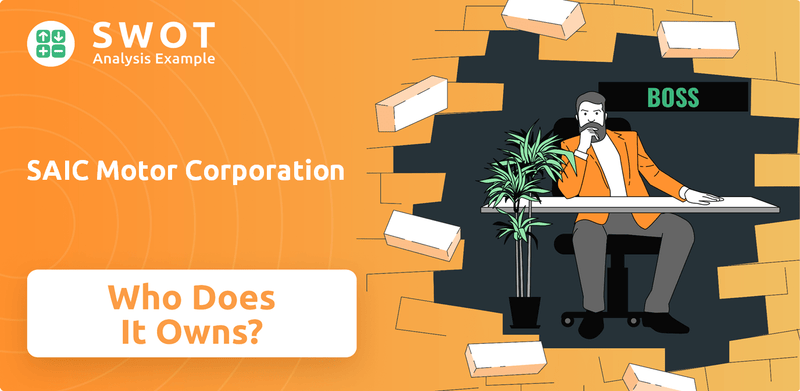
This exploration into
Who Founded SAIC Motor Corporation?
The story of SAIC Motor Corporation begins in 1955 with the establishment of the Shanghai Internal Combustion Engine Components Company. This marked the start of what would become a major player in the Chinese automotive industry. The early development of SAIC Motor Corporation was deeply rooted in China's state-owned enterprise system.
As a state-owned entity, the company's initial trajectory was shaped by the Shanghai Municipal Government. This government influence was critical in setting the direction for the company, particularly in establishing a local parts industry. Over the years, SAIC Motor Corporation underwent several name changes and mergers, reflecting the evolving strategies of the Chinese automotive sector.
The evolution of SAIC Motor Corporation showcases its transformation from a state-backed entity to a global automotive force. The company's history is a reflection of the broader changes within the Chinese economy and its automotive ambitions. The company's early structure and ownership were intrinsically tied to the Chinese government's industrial policies.
SAIC Motor Corporation started as the Shanghai Internal Combustion Engine Components Company in 1955.
This early phase was under the control of the Shanghai Municipal Government.
The state-owned structure was typical of China's planned economy at the time.
The Shanghai Municipal Government played a key role in SAIC Motor Corporation's development.
It mandated the creation of a local parts industry.
This shaped the company's early growth and direction.
The company went through several name changes.
These included Shanghai Power Machinery Manufacturing Company in 1958.
Later, the company became Shanghai Automotive Industry Corporation in 1990.
The first major joint venture was with Volkswagen in 1985.
This partnership allowed SAIC Motor Corporation to produce competitive cars.
It helped the company to expand its production significantly.
Production increased tenfold in the decade following the Volkswagen joint venture.
The company produced up to 300,000 units per year.
The Shanghai Municipal Government supported the development of a modern supply chain.
In 1998, SAIC Motor Corporation formed a second joint venture with General Motors.
This further accelerated its vehicle production capabilities.
The partnerships were key to the company's growth.
The evolution of SAIC Motor Corporation from its inception in 1955 to its later joint ventures with global automotive leaders like Volkswagen and General Motors highlights its strategic adaptation and growth within the Chinese automotive industry. The government's role in fostering these partnerships was crucial, as it facilitated technology transfer and accelerated production capabilities. For more insights into the company's strategic direction, you can read about the Growth Strategy of SAIC Motor Corporation.
SAIC Motor Corporation SWOT Analysis
- Complete SWOT Breakdown
- Fully Customizable
- Editable in Excel & Word
- Professional Formatting
- Investor-Ready Format
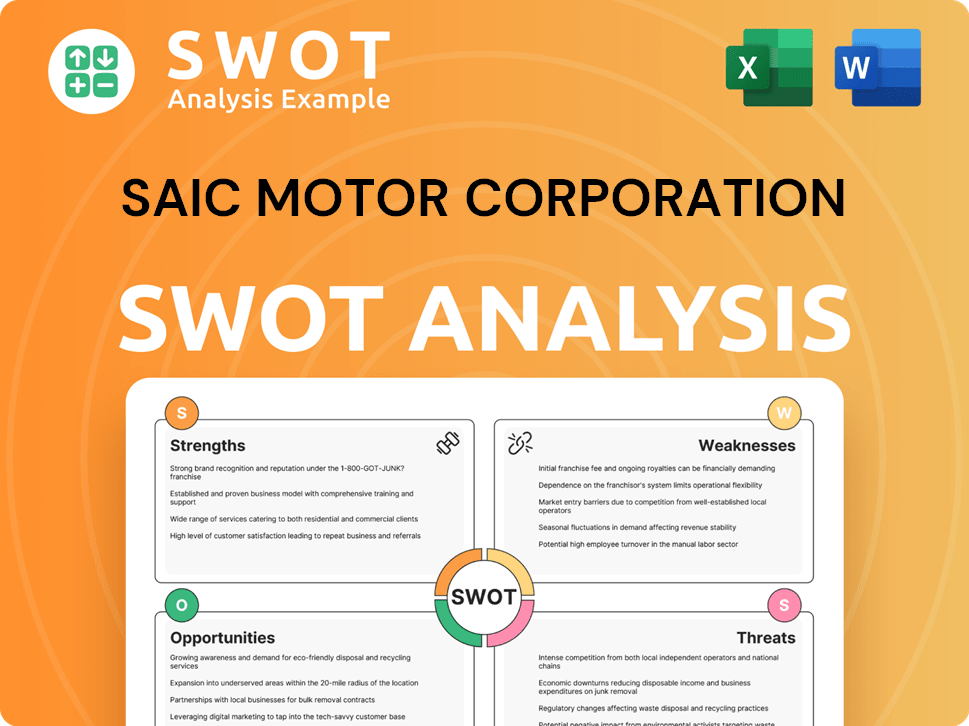
How Has SAIC Motor Corporation’s Ownership Changed Over Time?
The ownership structure of SAIC Motor Corporation has evolved significantly, reflecting China's economic reforms and the growth of its automotive industry. Initially a state-owned enterprise, SAIC transitioned to a publicly traded company, marking a key shift in its ownership. The full public listing occurred in 2011, opening the door for a more diverse shareholder base while maintaining significant government influence.
The influence of the Chinese government remains substantial, even as SAIC operates as a publicly listed entity. The State-owned Assets Supervision and Administration Commission (SASAC) of the Shanghai Municipal Government holds a large stake. This ownership structure is crucial to understanding SAIC's strategic direction and its role within the Marketing Strategy of SAIC Motor Corporation and the broader Chinese automotive industry.
| Ownership Aspect | Details | Data |
|---|---|---|
| Public Listing | Year of Full Public Offering | 2011 |
| Market Capitalization (June 2025) | Approximate Market Cap in USD | $25.98 billion |
| SASAC Ownership (2022) | Shanghai Municipal Government's Stake | 62.69% |
| SASAC Indirect Ownership (2022) | Indirect Government Stake | 66.80% |
| State Council Indirect Ownership | Indirect State Council Stake | 6.70% |
Beyond government stakeholders, institutional investors play a significant role in SAIC's ownership. As of May 14, 2025, there are 91 institutional owners and shareholders holding a substantial number of shares. Key institutional investors include Vanguard Total International Stock Index Fund Investor Shares (VGTSX), iShares Core MSCI Emerging Markets ETF (IEMG), and Vanguard Emerging Markets Stock Index Fund Investor Shares (VEIEX). Other significant holders include China COSCO Shipping Corporation Limited, China Securities Finance Corp, Asset Management Arm, Shanghai International Group Co.,Ltd. and Central Huijin Asset Management Ltd.
SAIC Motor Corporation's ownership structure is a blend of state influence and public market participation.
- The Shanghai Municipal Government, through SASAC, maintains a controlling stake, ensuring government influence.
- Institutional investors like Vanguard and iShares hold significant positions.
- SAIC's joint ventures, such as those with Volkswagen and General Motors, are key to its market position.
- SAIC's 2023 revenue was approximately ¥744.7 billion.
SAIC Motor Corporation PESTLE Analysis
- Covers All 6 PESTLE Categories
- No Research Needed – Save Hours of Work
- Built by Experts, Trusted by Consultants
- Instant Download, Ready to Use
- 100% Editable, Fully Customizable
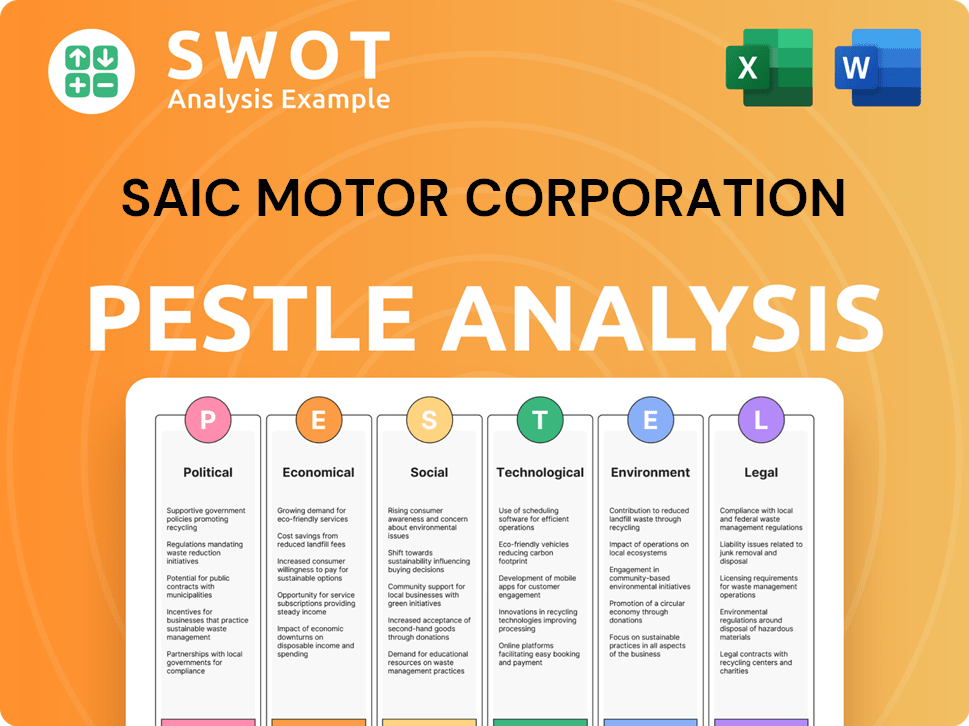
Who Sits on SAIC Motor Corporation’s Board?
The Board of Directors of SAIC Motor Corporation plays a critical role in its governance. As of the latest available information, Wang Xiaoqiu serves as the chairman of the Board of Directors, and Jia Jianxu is the president. Shen Xiaosu is the chairman of the board of supervisors. The composition of the board reflects the significant influence of the Shanghai State-owned Assets Supervision and Administration Commission (SASAC), the primary shareholder.
Due to the nature of SAIC Motor's state-owned enterprise status, the government maintains considerable influence over the board's composition and strategic decisions. This alignment ensures that the company's operations are in line with national and regional industrial policies. The board's decisions are likely to focus on long-term strategic goals, including the development of new energy vehicles and global expansion. For more details, you can explore Revenue Streams & Business Model of SAIC Motor Corporation.
| Board Member | Title | Affiliation |
|---|---|---|
| Wang Xiaoqiu | Chairman | Board of Directors |
| Jia Jianxu | President | Board of Directors |
| Shen Xiaosu | Chairman | Board of Supervisors |
The voting structure of SAIC Motor, as a publicly traded company on the Shanghai Stock Exchange (SSE: 600104), typically operates on a one-share-one-vote basis. However, the substantial stake held by the Shanghai Municipal Government through SASAC means it effectively wields outsized control and voting power. As of 2022, SASAC held a 62.69% parent ownership and 66.80% indirect beneficial ownership, highlighting the dominant control of the state.
The board is heavily influenced by the Chinese government through SASAC, ensuring strategic alignment with national goals. The voting structure is primarily one-share-one-vote, but state ownership gives the government significant control.
- Wang Xiaoqiu chairs the board.
- Jia Jianxu serves as the president.
- SASAC holds a majority stake, ensuring government influence.
- The company focuses on new energy vehicles and global expansion.
SAIC Motor Corporation Business Model Canvas
- Complete 9-Block Business Model Canvas
- Effortlessly Communicate Your Business Strategy
- Investor-Ready BMC Format
- 100% Editable and Customizable
- Clear and Structured Layout
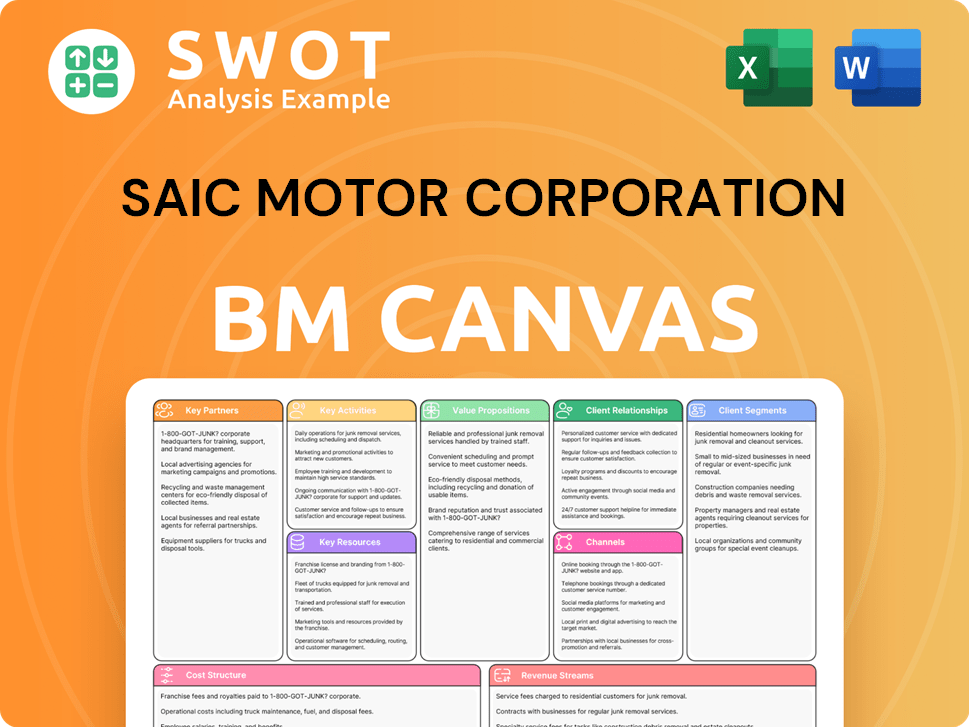
What Recent Changes Have Shaped SAIC Motor Corporation’s Ownership Landscape?
Over the past few years, SAIC Motor Corporation has seen shifts in its ownership and strategic direction. A key move in 2024 was the restructuring of a wholly-owned subsidiary into a joint venture with the JSW Group, indicating a trend towards strategic partnerships to boost international growth. Furthermore, SAIC Motor expanded its logistics capabilities in 2024 by commissioning advanced ocean car carriers, which supports its growing exports.
In terms of financial performance, SAIC Motor's net profit attributable to shareholders for the full year ended December 31, 2023, was 14.106 billion yuan, a decrease from 16.117 billion yuan in 2022. For the first half of 2024, the company reported a net profit attributable to shareholders of 6.63 billion yuan. The company projected a net profit attributable to shareholders of between 1.5 billion yuan and 1.9 billion yuan for 2024. This decline is attributed to a contracting oil-fueled vehicle market and intensifying price competition.
| Metric | Year | Value |
|---|---|---|
| Net Profit Attributable to Shareholders | 2022 | 16.117 billion yuan |
| Net Profit Attributable to Shareholders | 2023 | 14.106 billion yuan |
| Net Profit Attributable to Shareholders (H1) | 2024 | 6.63 billion yuan |
| Projected Net Profit Attributable to Shareholders | 2024 | 1.5 - 1.9 billion yuan |
A notable trend is the increasing institutional ownership in publicly traded Chinese companies. As of May 14, 2025, 91 institutional owners and shareholders hold a total of 39,159,312 shares in SAIC Motor. However, the State-owned Assets Supervision and Administration Commission (SASAC) of the Shanghai Municipal Government heavily influences the company’s ownership, holding 62.69% of the parent company in 2022 and 66.80% indirectly. This backing allows SAIC to navigate market challenges and pursue long-term strategies.
SAIC Motor has invested nearly 150 billion yuan in research and development, particularly in new energy vehicles (NEVs), over the past decade. The company launched 'Seven Technological Pillars 2.0' in 2024, including innovations like solid-state batteries and advanced intelligent driving systems. Strategic cooperations include a partnership with Audi in May 2024 to co-develop high-end intelligent electric vehicles and a smart digital platform. In November 2024, SAIC Motor and Volkswagen extended their joint venture agreement until 2040, committing to co-develop over ten new models, including pure electric and plug-in hybrids.
Despite advancements, SAIC Motor announced an impairment provision exceeding 7 billion yuan for 2025, mainly due to intangible assets and strategic adjustments in its NEV portfolio. This follows a 3.8 billion yuan provision in 2024. The company aims for over 2.9 million sales of self-owned brands by 2025, as part of its 2024-2027 strategic plan, involving business structure optimization and streamlining non-core businesses.
SAIC Motor Corporation Porter's Five Forces Analysis
- Covers All 5 Competitive Forces in Detail
- Structured for Consultants, Students, and Founders
- 100% Editable in Microsoft Word & Excel
- Instant Digital Download – Use Immediately
- Compatible with Mac & PC – Fully Unlocked
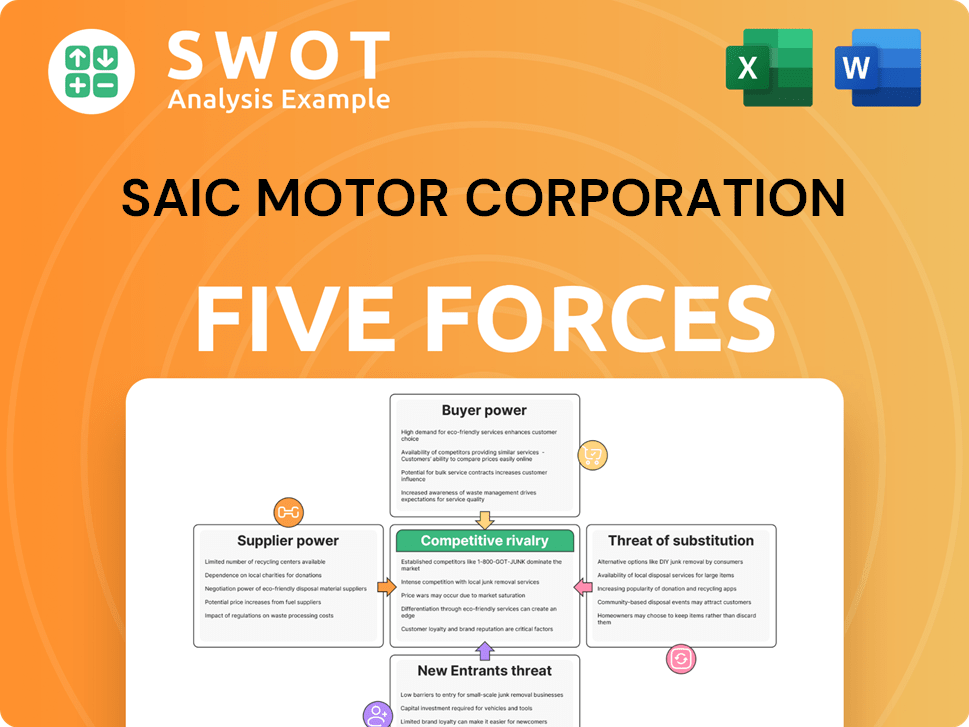
Related Blogs
- What are Mission Vision & Core Values of SAIC Motor Corporation Company?
- What is Competitive Landscape of SAIC Motor Corporation Company?
- What is Growth Strategy and Future Prospects of SAIC Motor Corporation Company?
- How Does SAIC Motor Corporation Company Work?
- What is Sales and Marketing Strategy of SAIC Motor Corporation Company?
- What is Brief History of SAIC Motor Corporation Company?
- What is Customer Demographics and Target Market of SAIC Motor Corporation Company?
Disclaimer
All information, articles, and product details provided on this website are for general informational and educational purposes only. We do not claim any ownership over, nor do we intend to infringe upon, any trademarks, copyrights, logos, brand names, or other intellectual property mentioned or depicted on this site. Such intellectual property remains the property of its respective owners, and any references here are made solely for identification or informational purposes, without implying any affiliation, endorsement, or partnership.
We make no representations or warranties, express or implied, regarding the accuracy, completeness, or suitability of any content or products presented. Nothing on this website should be construed as legal, tax, investment, financial, medical, or other professional advice. In addition, no part of this site—including articles or product references—constitutes a solicitation, recommendation, endorsement, advertisement, or offer to buy or sell any securities, franchises, or other financial instruments, particularly in jurisdictions where such activity would be unlawful.
All content is of a general nature and may not address the specific circumstances of any individual or entity. It is not a substitute for professional advice or services. Any actions you take based on the information provided here are strictly at your own risk. You accept full responsibility for any decisions or outcomes arising from your use of this website and agree to release us from any liability in connection with your use of, or reliance upon, the content or products found herein.